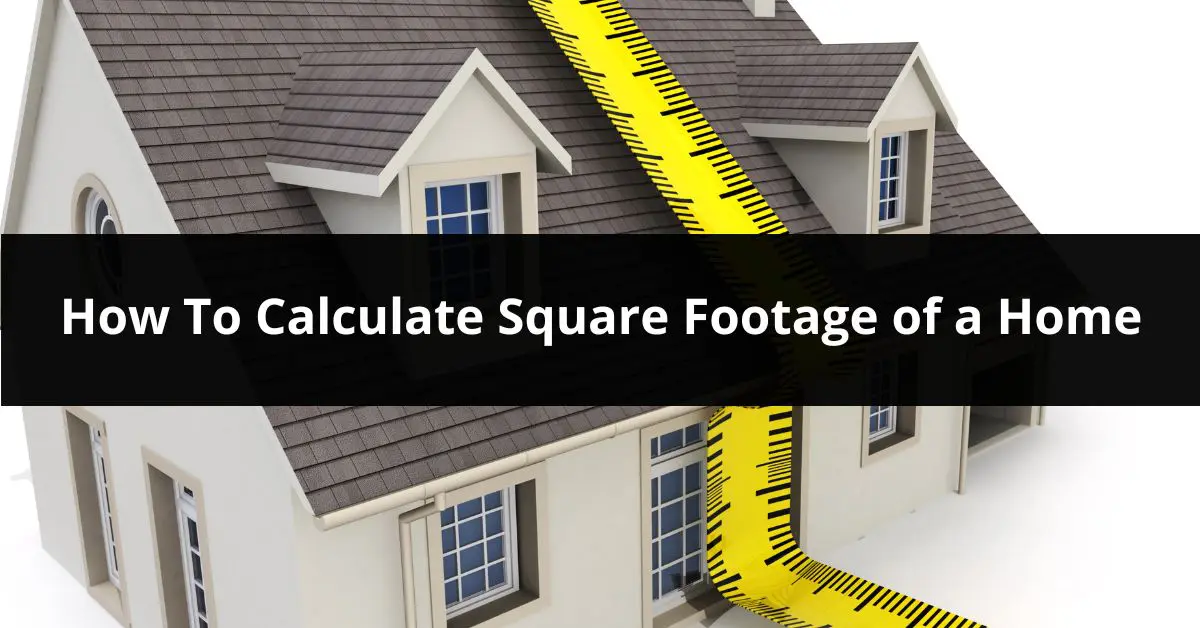Calculating the square footage of your house is easy once you know what counts as a square foot, and when it applies to your situation. For example, if you’re selling a house the square footage may just include livable space. If you’re getting a quote for a repair, upgrade, or addition, you’ll need to calculate a specific space instead.
This post walks you through multiple situations and shares easy-to-use formulas for non-standard rooms like a curved wall, a nook, and other spatial features. And this starts with knowing what square footage means in real estate.
What is Square Footage in Real Estate?
Square footage in real estate is the size of the living spaces that are inside the walls of the house. Some parts of a house are not included in square footage like a garage and unfinished spaces.
The square footage of your house impacts the listing price when you sell your house, and can make your property more or less attractive to potential buyers. And if you don’t have the square footage right, or as accurate as possible, you may find yourself in a lawsuit with the buyer.
To help prevent potential problems, here’s how to figure out the square footage of your house before listing it.
How to Calculate Square Feet
You will need:
- a tape measure
- calculator
- pencil or pen
- paper
Pro-tip: Have someone help you measure to save time and increase efficiency. One person can measure while the other writes down the measurements, and it’s helpful to have another person holding the other end of the tape on longer measurements. Also, before you start, make sure nothing is in the way that will throw off your measurements.
To calculate square feet, measure the length and width of the room in feet. Then, multiply the two numbers to get the total square feet.
The Standard Formula to Measure Square Footage is:
Length (ft) x Width (ft) = Total Square Feet (ft2)
How to Calculate Square Feet of a Room
If you had a rectangular room that was 14 feet long and 12 feet wide, you would calculate it like this:
Length (ft) x Width (ft) = total square feet (ft2)
14 ft x 12 ft = 168 ft2
The square footage of your room calculates to 168 square feet.
How to Calculate the Square Footage of a Room That Is Not a Square or Rectangle
Not all rooms come in squares and rectangles. To calculate the square feet of a room that has a different shape, like T-shaped room or a room with a bay window, you will have to do a few extra measurements.
- Measure the length and width of the main area of the room and multiply them together.
- Measure the length and the width of the space that is not a part of the main area and multiply them together. This would be the smaller sections of the L-shaped or T-shaped room or the area where the bay window is.
- Add together the square footage of the main area and the square footage of the smaller area to get the total square footage of the room.
Example:
If you have a main area that is 12 feet long by 10 feet wide with a rectangular bay window that is 4 feet long by 2 feet wide, you would calculate it like this:
- Main area square footage
12 ft x 10 ft = 120 ft2 - Bay window square footage
4 ft x 2 ft = 8 ft2 - Total square footage
120 ft2 + 8 ft2 = 128 ft2
How to Calculate the Square Feet of a Room with a Curved Wall
There is a little more math involved to calculate the square feet of a room with a curved wall or cove.
- Start by finding the square footage of the main area by multiplying the length times the width.
- Measure the area of the room with the curved wall. Do this by measuring through the center of the space at the point where it is the longest and the widest.
- Divide the length by half
- Multiply this number by the width
- Multiply this total by 3.14 (pi). This will give you the area of a complete circle (or oval).
- Divide the area of the complete circle (or oval) in half since your curved area is only half of that. Now you have the square footage for the area with the curved wall.
- Add the square footage of the curved-wall area to the main area square footage to get the total for the room.
Example:
Let’s say your room has main area measurements of 14 feet long by 12 feet wide and its curved-wall area is 5 feet long and 4 feet wide.
-
Main area square footage
14 ft x 12 ft= 168 ft2
-
Curved-wall area square footage (5 feet long by 4 feet wide)
a. Divide length in half – 5ft/2= 2.5 ft
b. Multiply by the width – 2.5 ft x 4 ft= 10 ft2
c. Multiply by 3.14 – 10 ft2 x 3.14= 31.4ft2
d. Divide in half to get total square footage of area with the curved wall 31.4ft2/2= 15.7ft2 -
Add together to get total square footage of room
168ft2 + 15.7 ft2 = 183.7 ft2
How to Calculate Square Feet of a House
You can calculate the square feet of your house one of two ways.
- You can measure the square feet in each room of the house. Add up the square footage of all the rooms to get the total for the house.
- If you have three rooms in your house, and one is 100 square feet, another is 80 square feet and the third is 200 square feet. The total square footage for your house would be 100 + 80 + 200, so the total would be 380 square feet.
- You can measure the area outside your house around the foundation. Multiply the length times the width to get the total. Don’t include any unfinished spaces in your measurement, like a garage.
If you have a two-story home, and the second story is the same size as the first, double the measurement to get the total.
How to Calculate Square Feet from Inches
If you measured a room in inches and want to change it to feet, divide the square inches value by 144.
Square Inches of a Room / 144 = Square Footage of the Room
Example:
Your room measures out at 120 inches long by 96 inches wide.
120 inches x 96 inches = 11,520 in2
Room = 11,520 in2
Total square feet = 11,520 in2 / 144 = 80 ft2
How to Calculate Square Feet of a Wall
You calculate the square feet of a wall just like a room, so you can use the formula from above:
Length (ft) x Width (ft)= Total Square Feet
If the wall has windows or doors, subtract the area of the windows and the doors from the total. This especially helps if you are figuring out how much paint or wallpaper you need. No need to pay for extra!
What Is Livable Square Feet vs. Non-livable Square Feet
Livable space can be counted in the square footage of the house and is the space within the rooms you live in like the kitchen, living room and bedrooms. Non-livable space are rooms you will not be doing every day activities like the garage, bathrooms or closets.
Here are three questions to help you decide if a space is livable or non-livable.
- Does the room share the same HVAC (heating and A/C) system as the main home?
- Is it located above ground?
- Does the style “fit in” with the rest of the home? Is it built to the same standard?
If the answer is yes to these three questions, then the space is most likely livable space.
Examples of livable space:
- Bedrooms, bathrooms, kitchens, dining rooms, living rooms, and dens
- Finished attic space (must be on the main home’s heating system and have seven feet of clearance)
- Enclosed porches (only if they are enclosed on all four sides, have a roof and are heated from the main home’s heating system)
Examples of non-livable spaces:
- Below grade spaces (like basements, even if they are finished)
- Unfinished attics
- Porches
- Garages
- Detached living spaces (like pool houses, sheds and living spaces that can’t be accessed from the main home)
- Open spaces (if you have an area on your second floor that is open to the living rooms, it isn’t counted since it does not have a floor)
How to Calculate Livable Square Feet vs. Non-livable Square Feet
To calculate livable square feet vs. non-livable square feet, all you need to do is find the square footage of all the rooms that are considered livable space and add them together. This is just like calculating the square footage of a house as shown above, but not including non-living spaces.
You could also measure the outside of your home around the foundation, multiply length times width to get the total, and subtract the square footage of any non-livable space.
Example:
Your house measures 50 feet long and 40 feet wide on the outside, including a garage that is 12 feet by 10 feet.
Outside of house – 50 ft x 40 ft= 2,000 ft2
Garage – 12 ft x 10 ft= 120 ft2
Total square feet – 2,000 ft2 – 120 ft2 = 1,880 ft2
How Does the Size of Your Home Impact a Listing, Sale Price and What Needs to Be Disclosed
The size of your home and condition are the two most important things that determine the value of your house. If you think your house is bigger than it is, you could price it too high. It may take a longer time to sell, and you might get less for it than you were expecting. On the other hand, if you think it is smaller than it really is, you could price it too low and leave money on the table. You don’t want either of those things to happen, and that is why it is so important to know the true number.
What if you have different measurements for square footage?
For example, what if tax records say one thing, you measured something else, and an appraiser came up with a different number. You should go with your best guess, but it should be disclosed to let buyers know there are differences, and you aren’t sure which one is correct. It is always better to give more information than not enough!
You can also contact your area’s assessment department and ask them for a data review. If you wish, you can hire an appraiser to calculate your square footage to submit to the assessment department for the review.
Square footage in real estate is pretty easy to figure out once you know how. Now that you are armed with all of the information on how to do it, grab your tape measure and start measuring!


